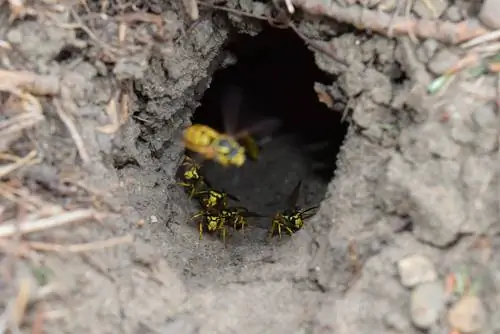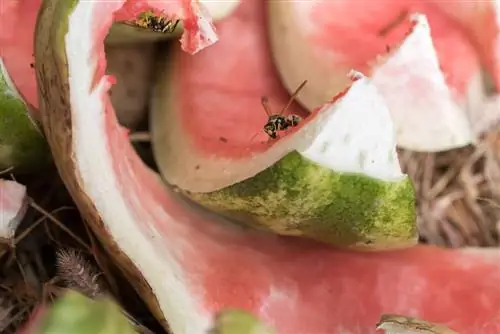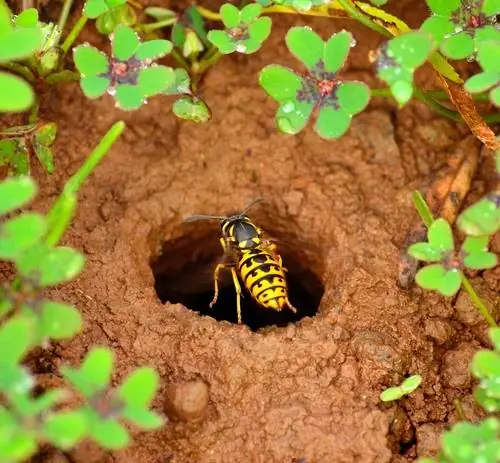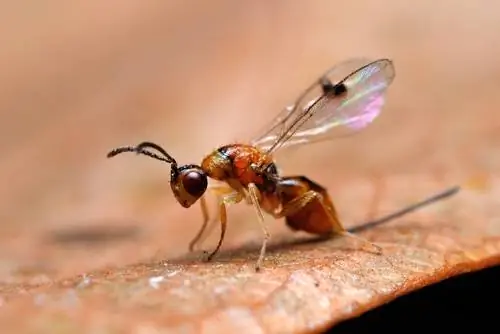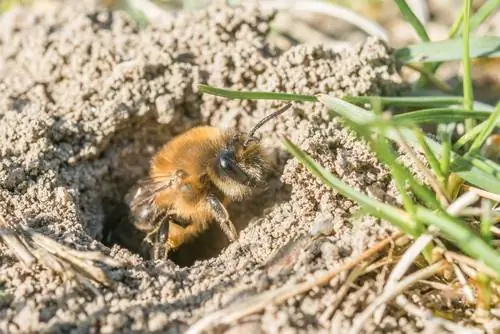- Author admin [email protected].
- Public 2023-12-16 16:46.
- Last modified 2025-06-01 06:02.
Earth wasps don't have a particularly good reputation. They are labeled as dangerous and aggressive insects and are considered annoying insects. But the Hymenoptera take on numerous functions in the ecosystem. They have an exciting way of life and in most cases do not pose a danger.

What helps against earth wasps?
If you want to get rid of earth wasps, you should get professional help. Unauthorized attempts to eliminate and eradicate using gasoline or other methods can result in unpleasant surprises. In many federal states, the removal and destruction of wasp nests is prosecuted under criminal law, so a fine can be expected.
Products such as wasp foam or anti-wasp spray poison and kill the insects. Although manufacturers often promise ecological and gentle effects, you are putting yourself at risk. The nest is disturbed and the workers try to defend themselves by stinging.
Get advice here:
- Lower nature conservation authority of your district office
- local fire department
- regional NABU office
- in Bavaria: LBV
- Wasp emergency service or beekeeper
Smoke out or drown
This method is comparatively old and often does not achieve the desired success. Twigs and brushwood are piled up in front of the entrance hole and set on fire so that the smoke penetrates into the earthworks. The animals become very aggressive and can attack. In order to drive away the wasps sustainably, several repetitions are necessary.
Another measure to kill ground wasps is flooding the caves and passages. Sugar water is piped into the building. The sugar is supposed to stick the insects' wings together so that they can no longer fly. This method is also only effective after repeated repetition and means a painful death for the animals.
Moving entrance hole
This method is not entirely safe because you have to get close to the wasp's nest. If you are unsure, you should consult a specialist. Such measures should be carried out during the morning or evening hours as the animals are less active during this time.
You need a two meter long drain pipe and a suitable piece of pipe that is bent at 90 degrees. Put both pipe parts together. The angled piece is inserted into the hole in the ground so that the long part with the pipe opening points into a safe area.
Tip
If you are bothered by wasps on your patio or balcony, simply place a bowl filled with sugar water at a safe distance. This attracts wasps and keeps them away from the coffee table.
Relocating earth wasps
Moving a nest only makes sense if it is in an inconvenient location. Before the procedure, a specialist anesthetizes the insects with an animal-friendly sedative so that the wasps become dazed. The nest can then be safely dug out of the ground and placed in a remote location. This measure can only be carried out until mid-July, as the wasp population then grows rapidly.
Excursus
What to do if you get a wasp sting?
When wasps feel threatened, they sting. This is also the case with earth wasps. Anyone who is unlucky enough to have been stung by a wasp should react quickly. These remedies help to keep the pain within limits:
- cool
- grate sliced onion on the sting
- cold vinegar (disinfects and cools)
- If possible, don’t itch!
What do earth wasps eat?

Wasps like nectar, but also attack other insects to feed their larvae
The diet of adult earth wasps is predominantly vegetarian. The hymenoptera feed on plant juices that contain energy-rich sugar compounds. Young queens are often found on willow flowers in spring. But the smell of food and drinks also attracts insects. Once she discovers the rich food source, she is difficult to drive away. Larvae are fed a protein-rich paste made from chewed insects and other animal proteins.
What are earth wasps?
Earth wasps are a colloquial name for wasps that settle in the ground. In Germany there are two species of wasps from the genus short-headed wasps, which nest in holes in the ground. These include the common wasp and the German wasp. Together with hornets and long-headed wasps, they form the subfamily of real wasps.
Identifying earth wasps
When the insects are on an exploratory flight, they can be easily recognized. After earth wasps have found an optimal place to build their nest, the hustle and bustle of the colony begins. Holes made by earth wasps can be seen in the ground, which are used for entry and exit.
Species
Garden owners most often come across the German wasp or the common wasp. Both species occur in similar habitats and exhibit aggressive behavior when they feel threatened. They often seek proximity to humans because they are attracted to the smells of sweet baked goods and drinks.
| Common wasp | German wasp | |
|---|---|---|
| Drawing on the front plate | wide black line, thickened towards the bottom | broken black line or dots |
| Size | 11 - 20 mm | 12 - 20 mm |
| Nest Color | light, beige | greyish |
| Material for nest building | rotten wood from rotting tree trunks | superficially weathered wood from fences |
Lifestyle
A colony of wasps lives for one summer. There is a fixed hierarchy and division of labor in the community. This is the only way the state can function and ensure the continued existence of the species.
Nest building
From April, the fertilized queen looks for a hole in the ground in which she builds her nest. These can be dark cavities or abandoned mouse holes. She eats a lot of food in the first two to three weeks. The nest is then formed from chewed wood fibers.
This is what the initial nest looks like:
- a central brood cell
- six more cells surround the center
- Nest hanging upside down on cave ceiling
- Honeycombs protected by spherical nest cover

Founding a wasp colony
Shortly before the eggs are laid, the eggs are fertilized with stored sperm. The female has been carrying this supply with her since mating last fall. One egg is laid per brood cell. The hatched larvae are fed by the queen with a paste made from crushed insects.
The larvae secrete a liquid drop that is rich in sugar. The queen takes this up. After the larvae pupate, they shed their skin several times inside the pupa. The young earth wasps hatch after about two to three weeks.
Excursus
Larval development
Wasps are clean insects that keep their nest very clean. The larvae only defecate shortly before pupating so that the excretions do not rot in the nest. The queen can control the sexual development of her offspring. It secretes pheromones and thereby prevents the creation of further females capable of fertilization. In this way, the queen creates her colony of infertile workers. Only the queen is responsible for further reproduction.
Development of the state
The workers are responsible for further expanding the nest. They create additional brood combs that are arranged in several levels. In this way, the nest and the colony can expand rapidly. It is not uncommon for a wasp colony to consist of 3,000 to 4,000 individuals.
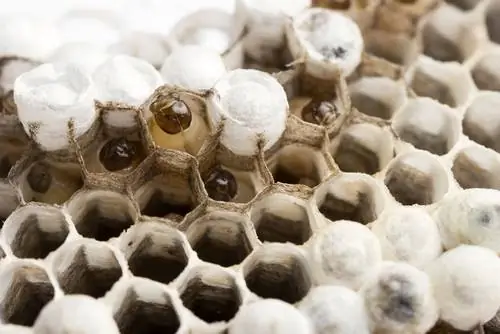
A wasp colony can consist of up to 4000 wasps
The expansion continues until late summer. The queen now secretes fewer pheromones so that fertile females develop. They are the new generation of queens. Males hatch from unfertilized eggs by early autumn, which also represents the end of the colony. The nest is slowly dying out as new workers are no longer being produced.
This is what the division of labor in the state looks like:
- Nest expansion
- Cleaning the cells
- Feeding the larvae
- Queen's supplies
- Food procurement
Mating and Downfall
The old queen dies in autumn. Males fly out and look for females from other colonies to mate with so that no inbreeding occurs. The males die shortly after mating. By the time the cold snaps at the latest, all insects in a state have died. Only the fertilized young queens look for a protected hiding place to overwinter. They use rotten wood, cavities under bark or moss cushions to fall into winter torpor. During this so-called diapause, all vital functions are switched to energy-saving mode.
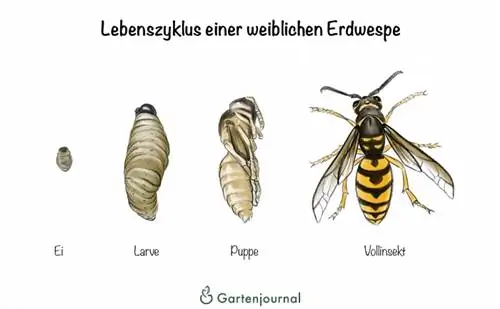
Difference between earth wasps and earth bees
Earth wasps are very often confused with earth bees, which can have fatal consequences. Earth bees are completely harmless and pose no danger to humans. The useful insects are protected, which is why their burrows must not be removed and destroyed for no reason.
Not only does the appearance of earth wasps and earth bees differ, but also the structure and behavior of both groups. Bees often communicate using a waggle dance to convey the distance and direction of a food source. This behavior does not occur in wasps.
| earth wasps | Earth Bees | |
|---|---|---|
| Number of entry holes | one entrance | multiple entrances |
| Lifespan of a cave | for one year | over several years |
| Honeycomb arrangement | horizontal | vertical |
| Body | slightly hairy in places | furry hairy |
Which animal eats earth wasps?
There are a number of natural enemies that keep earth wasp populations in check. Many animals have specialized in stinging insects by developing protective mechanisms or parasitic lifestyles. In addition, humans are one of the biggest enemies of wasps, because the use of insecticides in agriculture kills off many colonies.
Mammals
In this group of animals there are numerous predators that target the protein-rich earth wasp brood. These include smaller mammals such as shrews and hedgehogs, but also badgers. However, none of the animals specializes in earth wasps. If the insects fly outside the nests, there is little chance for the predators to catch one of the flying animals.
Birds
Some birds specialize in hunting flying insects. Red-backed shrikes and bee-eaters are among the most important predators of earth wasps. The honey buzzard has also specialized in stinging prey. The birds of prey dig up the nests of the common, German and red wasps to eat the energetic brood. They are often stung by the workers because they are defending their nest. This is why the honey buzzard closes its eyes while digging. The dense feathers on its head protect it from the stings.
Insects
Numerous insects have specialized in hunting wasps. There are some animals that live parasitically and kill numerous earth wasps in this way. Ants can also pose a danger to the wasp brood, as they occur in large numbers and are aggressive. The caterpillars of some wax moth species also feed on the earth wasp brood, with mainly bee and bumblebee larvae on their menu.
Why these insects are suitable wasp hunters:
- Dragonflies: agile and fast flight artists, powerful jaws to kill
- Robber flies: strong legs for catching, stinging proboscis for sucking out
- Dickhead flies: lay eggs on flying wasps, larvae eat the host from the inside
- Wasp beetles: Beetle larvae bore into wasp larvae
Where do earth wasps live?
Earth wasps are found in large parts of Europe. They populate almost all landscapes and are often found in human settlements. Holes in the ground are an important prerequisite for earth wasps to find a suitable nesting place. Not only shrubs but also various tall perennial plants grow in their natural biotope. They occur near forests and in horse pastures.
Earth wasps also occur here:
- in the garden
- between paving stones
- under terraces
- in flower box or flower pot
In the house
Earth wasps are not only found in holes underground. Cavities in walls and blinds or undisturbed attics also provide suitable housing for the insects. If you notice a buzzing noise in the apartment in the summer months but cannot locate it, wasps are probably the cause. It could also be bees or hornets.
Are earth wasps protected?
All wasp species are protected by the Federal Nature Conservation Act. The insects must not be caught, injured, killed or intentionally disturbed. Protection also applies to the nest. There are exceptions to these prohibitions. There must be a public interest or an unreasonable burden on the individual. Wasp nests in the daycare center may be professionally removed after obtaining permission.
Danger vs. Benefit
Earth wasps display aggressive behavior. They are not afraid to be close to people and will not simply fly away when you strike at them. The insects perceive such measures as a threat against which they must protect themselves. Stings occur. When children are playing in the garden and accidentally step on a hole in the ground, the earth wasps also feel threatened and often attack.
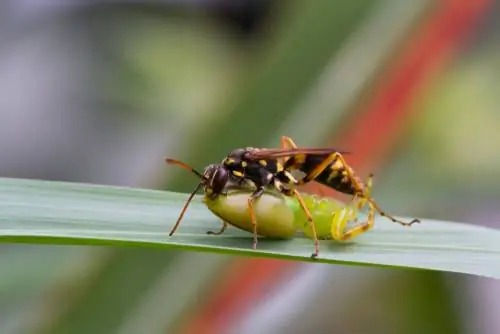
Wasps are good pest controllers
But wasps also play a major role in pest control. They need animal proteins to raise their brood. To do this, they go hunting and capture various insects and arachnids. Adult insects feed exclusively on sweet plant juices, but they also like to vacuum up aphid excretions. In this way, wasps prevent fungi from settling on the infected plants. At the same time, wasps also attack the aphids themselves and prevent them from spreading en masse.
What earth wasps prey on:
- Types of flies
- other Hymenoptera
- Caterpillars of day and night butterflies
- Grasshoppers and Spiders
- Brakes
Earth wasps are not monsters that take revenge on humans by any means possible. They are beneficial insects in the ecosystem and ensure that pests do not spread uncontrollably.
Prevention
To prevent earth wasps from settling in the garden, the preferred food plants should not be planted. Wasps have specially designed mouthparts that allow them to only suck out nectar sources that are easy to reach. Therefore, there are some plants that are more often attacked by wasps. This includes not only flowering plants, but also some ferns such as the bracken. These spore plants have nectar glands on the petioles that are easy for wasps to reach.
Typical wasp plants:
- Brown and Swamproot
- two-leaf
- Thyme
- some umbelliferous plants
- Ivy and buckthorn
Tip
Collect overripe fallen fruit and cover the compost well. Earth wasps cannot resist sweet and savory smells from leftover food or fruit.
Prevent nest building
There are some plants that give off an intense scent. Since earth wasps are very sensitive to smells, you can take advantage of plants with a smell that deters wasps. Place intensely smelling culinary herbs such as lavender, mint or basil in planters and distribute them on the balcony and garden. Tomatoes and garlic also exude aromas that scare away wasps.
Make soil unattractive
Abandoned earth nests should be destroyed in autumn. Fill the passages with substrate and tamp down the soil. If there are no holes and caves, the garden appears less attractive to earth wasps. Open soil in beds should be dug up regularly. This also closes underground passage systems and holes on the surface.
Frequently asked questions
Do ground wasps die in winter?
Apart from the young queens, all earth wasps in a colony die as soon as the first frosts appear. The queen is looking for a sheltered hiding place to overwinter in order to build a new state next year. It survives the winter in dead wood or building niches.
What do earth wasps look like?
The insects are clearly recognizable by their coloring. They have a typical black and yellow striped pattern that is intended to serve as a warning color. Another characteristic feature is the constricted abdomen, which is known as a wasp waist.
Can earth wasps sting?
Earth wasps have a stinger that does not get stuck in the skin after a sting. They introduce poison into the wound, which often causes swelling. In most cases, symptoms subside after three to four days. Some people are allergic to wasp stings, so a sting can quickly become dangerous. Medical treatment is advisable in this case.
What is the lifespan of earth wasps?
The workers live for a summer and die in the winter. Males do not develop until fall. They die shortly after mating, which takes place before winter. Only the queens have a life expectancy of about one year.
Are earth wasps coming back?
Earth wasps only use a nest once. However, young queens often orientate themselves by smells. They like to come back to places that were colonized by wasps last year. You should therefore clean the area thoroughly in winter after removing the nest.

